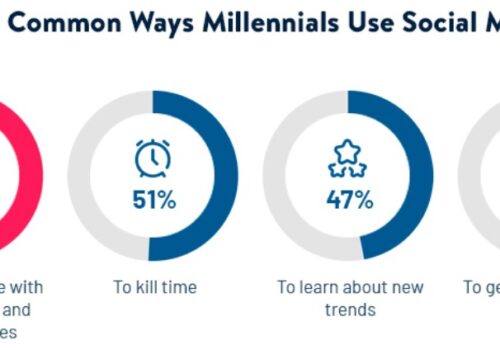In this post, we’ll go over a few of the most important Video Marketing Stats for 2022, which will help you see why now is the perfect time to start using video marketing.
Use these brief and simple video marketing stats to help you plan your 2022 video marketing strategy.
If the future is video marketing, then it has arrived. If you’ve been debating whether or not it’s worth investing in video marketing for your company, you’ve come to the correct place.
Do you have sufficient resources to produce videos? Is your target audience sufficiently interested in videos? Could it be worth the hassle in the end? In a word, absolutely.
Before we get into the video marketing statistics, let’s take a look at the many sorts of video content you may use to promote your company.
Explainer videos, which are short videos that describe products or services, are one of the most common video content formats used by organizations.
Video interviews, Vlogs (video blogs), tutorials, video presentations, product evaluations, recordings of live streams, video commercials, product demos, and video testimonials are all popular sorts of video content.
Top 10 Video Marketing Stats 2025
Now let’s look at the video marketing statistics and see what it has to reveal. We’ve gathered the most up-to-date data to ensure that your video marketing approach for 2022 is spot-on.
1. Video Content Is Enjoyed By Internet Users All Over The World
Video material is becoming increasingly popular.
In 2020, the number of individuals viewing online videos in the United States will have risen to 244.4 million, considerably exceeding the predictions of experts (Business Insider, 2020).
Despite the fact that researchers claim that the youngest & oldest age groups are driving this rise, the newest data shows that young adults are still the majority of digital video viewers. In fact, digital viewers account for nearly 9 out of 10 US customers aged 12 to 44.
A closer examination reveals that 97.8% of US web users aged 18 to 24 perceive themselves to be online video consumers. Individuals aged 12 to 17 are the most likely to view videos online, with 96.2 percent of them doing so.
The age bracket with the least amount of digital video viewing is 65 and up. Merely 63.8 percent of individuals in this age bracket use the internet to watch videos.
5. Profit = Video Marketing
It’s all about the return on investment ( ROI). Looking at the facts, 88 percent of video marketers are happy with the return on their social media video marketing efforts (Animoto, 2018).
According to the same survey, 80 percent of marketers are pleased with the return on investment of video commercials they have shared on social media.
Brands use video marketing, in general, to generate sales, establish brand awareness and trust, keep current consumers updated, and connect with future customers. Facebook, Instagram, and Youtube are the most popular venues for marketers to upload video advertising and social media marketing videos.
The ability to convey everything in a style that users like — the visual format — is one of the reasons why video marketing is valued as a marketing technique. End-users are particularly fond of tutorials or explainer movies.
6. Using Video Marketing to Generate Leads
Video marketers earn 66 percent more qualified leads each year, according to Optinmonster (Optinmonster, 2019). Video marketers obtain a 54 percent increase in brand recognition, according to Optinmonster. Furthermore, 93 percent of marketers claim to have gained a new consumer as a result of a social media video.
This improved lead quality can be linked to the educational value that video provides. Customers not only build trust in businesses, but they may also learn more about themselves or their products through interactive images.
These figures illustrate that there’s no need to doubt the value of video marketing for businesses. Video marketing will be a terrific approach to expand your network and consumer base in 2022, not only in the present but also in the coming years.
7. Video Marketing in Social Media Networks in the Year 2021.
Now that we’ve established that video is a highly beneficial marketing resource and that users enjoy watching brand videos on social networks, the next question is: where are marketing companies concentrating their video marketing efforts?
Youtube is the largest social media channel for marketers to broadcast videos, according to the most recent video marketing statistics. Nearly 9 out of 10 (89%) marketers expect to use YouTube for video marketing (Wyzowl, 2021).
The behemoth of social media, Facebook, comes in second. 7 out of 10 marketers intend to use the platform for video marketing. LinkedIn is a very new player in the video marketing space, having only released video services in 2017.
However, it has already surpassed other social media platforms such as Twitter & Instagram to become the third most popular channel for video marketing. In 2021, just under two-thirds of marketers (63%) expect they will use video on LinkedIn.
8. Video’s Influence on Buying Decisions
Videos not only keep people involved but also help them make decisions. According to a Wyzowl poll, nearly 8 out of 10 customers have purchased software or an app after watching a promotional video (Wyzowl, 2018).
The impact of video marketing may be felt throughout the customer’s journey, according to the same study, which found that the majority of customers (96 percent) use videos to understand more about a product or service.
Plus, if even internet behemoths like Google call videos “essential,” you know you’re on the right road by including video into your digital marketing approach. Video impacts internet users by serving as a shopping list, providing consumers with additional information & confidence to make purchases, and providing product reviews, According to Google.
9. Video’s Growing Popularity
If the benefits of video marketing haven’t yet persuaded you, consider this: the amount of time individuals consume viewing online videos is soaring.
Users spend an estimated 6 hrs and 48 mins per week watching online videos in 2019, up 59% from just 3 years previous in 2016. (Limelight, 2019).
And all indications suggest that this trend will continue. People under the age of thirty-six are already spending more time online watching videos than on conventional broadcast platforms like televisions.
In regards to everyday usage, the worldwide proportion of video intake per day is currently 84 minutes, with China and Sweden leading the way with 103 minutes per day spent watching online videos in 2019. By 2020, the worldwide average is predicted to rise to 100 minutes per day.
10. The Importance of Video in Internet Traffic
This should come as no wonder that the video’s industry share in web traffic is projected to grow, given its growing popularity.
Video broadcasting and downloads are expected to account for 82 percent of global internet traffic by 2022. (Cisco, 2019). From 72.3 percent in 2017, this is an increase of 88 percent in traffic share.
To put things in perspective, in 2017, 56 exabytes of internet video (equal to a billion gigabytes) were accessed on a monthly basis. By 2022, this statistic will have quadrupled to 240 exabytes each month.
It’s not simply that the viewership of uploaded videos is expected to rise. According to the same Cisco study, traffic from live web videos will grow 15-fold from 2017 to 2022, accounting for 17% of cumulative internet video traffic by 2022 – an important video marketing factoid to consider, especially if you’re contemplating using Facebook or Instagram live videos to advertise your dropshipping business!
Quick Links:
- Social Network Usage Stats: How Many People Would Be Using Social Media?
- TikTok Statistics You Need To Know: How Do I Check My TikTok Stats?
- E-Learning Stats and Trends: New Stats
Conclusion: Video Marketing Stats 2025
That’s all there is to know about 2022 video marketing stats. We hope this article has given you some insight into how video marketing might benefit your eCommerce business!
If you’re considering spending on video marketing, you’ll be relieved to learn that you don’t need a large budget or outside resources to get started. When it pertains to video creation, smaller businesses aren’t at a disadvantage.
The remarkable example of the Dollar Shave Club, which evolved from a video that went viral into a billion-dollar company, is a good illustration.
This only demonstrates that you don’t need a full production team to get started with video marketing.
Do let us know in the comments below if you have any expertise with video marketing & would want to share your opinions or if you have any queries!
Sources:
- https://www.impactplus.com/blog/how-dollar-shave-club-grew-from-just-a-viral-video-to-a-615m-valuation-brand
- https://www.mediapost.com/publications/article/340714/time-spent-watching-online-video-expanding-to-100.html
- https://www.limelight.com/resources/white-paper/state-of-online-video-2019/
- https://www.wyzowl.com/video-marketing-statistics/
- https://www.businessinsider.com/us-digital-video-viewership-will-grow-faster-than-expected-2020-10?r=US&IR=T
- https://blog.hubspot.com/marketing/content-trends-preferences
- https://wyzowl.s3.eu-west-2.amazonaws.com/pdfs/Wyzowl-Video-Survey-2021.pdf
- https://animoto.com/blog/business/2018-social-video-consumer-trends
- https://animoto.com/blog/business/2018-social-video-marketer-trends
- https://optinmonster.com/video-marketing-statistics-what-you-must-know/
- https://optinmonster.com/awareness-stage-content-strategy-and-examples/
- https://www.oberlo.com/blog/facebook-statistics#1_Facebook_The_King_of_Social_Media
- https://blog.linkedin.com/2017/august/22/Introducing-LinkedIn-Video-Show-Your-Experience-and-Perspective







